
- Saint of the Day

Presentation of the Blessed Virgin Mary
- November 21
- Franciscan Media
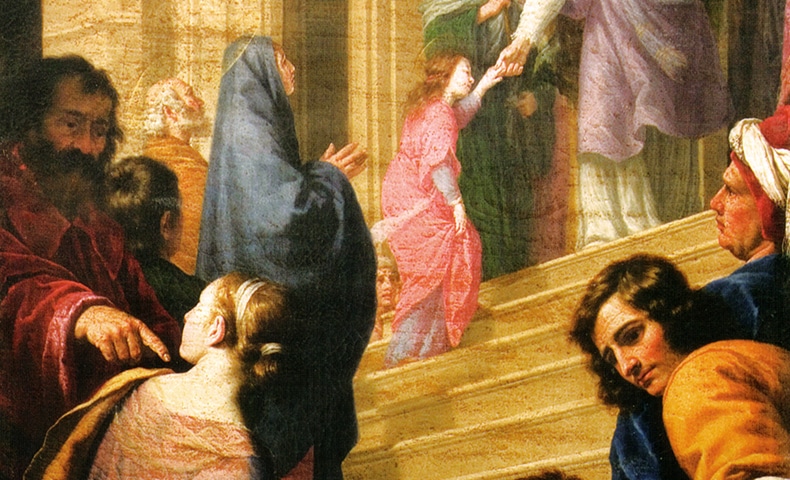
Image: Presentation of Mary in the Temple | Alfonso Boschi | photo by sailko
Saint of the day for november 21.
The Story of the Presentation of the Blessed Virgin Mary
Mary’s presentation was celebrated in Jerusalem in the sixth century. A church was built there in honor of this mystery. The Eastern Church was more interested in the feast, but it does appear in the West in the 11th century. Although the feast at times disappeared from the calendar, in the 16th century it became a feast of the universal Church.
As with Mary’s birth, we read of Mary’s presentation in the temple only in apocryphal literature. In what is recognized as an unhistorical account, the Protoevangelium of James tells us that Anna and Joachim offered Mary to God in the Temple when she was 3 years old. This was to carry out a promise made to God when Anna was still childless.
Though it cannot be proven historically, Mary’s presentation has an important theological purpose. It continues the impact of the feasts of the Immaculate Conception and of the birth of Mary. It emphasizes that the holiness conferred on Mary from the beginning of her life on earth continued through her early childhood and beyond.
It is sometimes difficult for modern Westerners to appreciate a feast like this. The Eastern Church, however, was quite open to this feast and even somewhat insistent about celebrating it. Even though the feast has no basis in history, it stresses an important truth about Mary: From the beginning of her life, she was dedicated to God. She herself became a greater temple than any made by hands. God came to dwell in her in a marvelous manner and sanctified her for her unique role in God’s saving work. At the same time, the magnificence of Mary enriches her children. They—we—too are temples of God and sanctified in order that we might enjoy and share in God’s saving work.
Click here for more on Mary!

Sign Up for Our Daily Newsletter
Includes Saint of the Day, Minute Meditations, and Pause + Pray.

Our Mission
- Phone: (513) 241-5615
- Address: 28 W. Liberty St. Cincinnati, OH 45202
Writer’s Guidelines Privacy Policy Post a Prayer Request Donor Portal Our Mission
Recent Articles
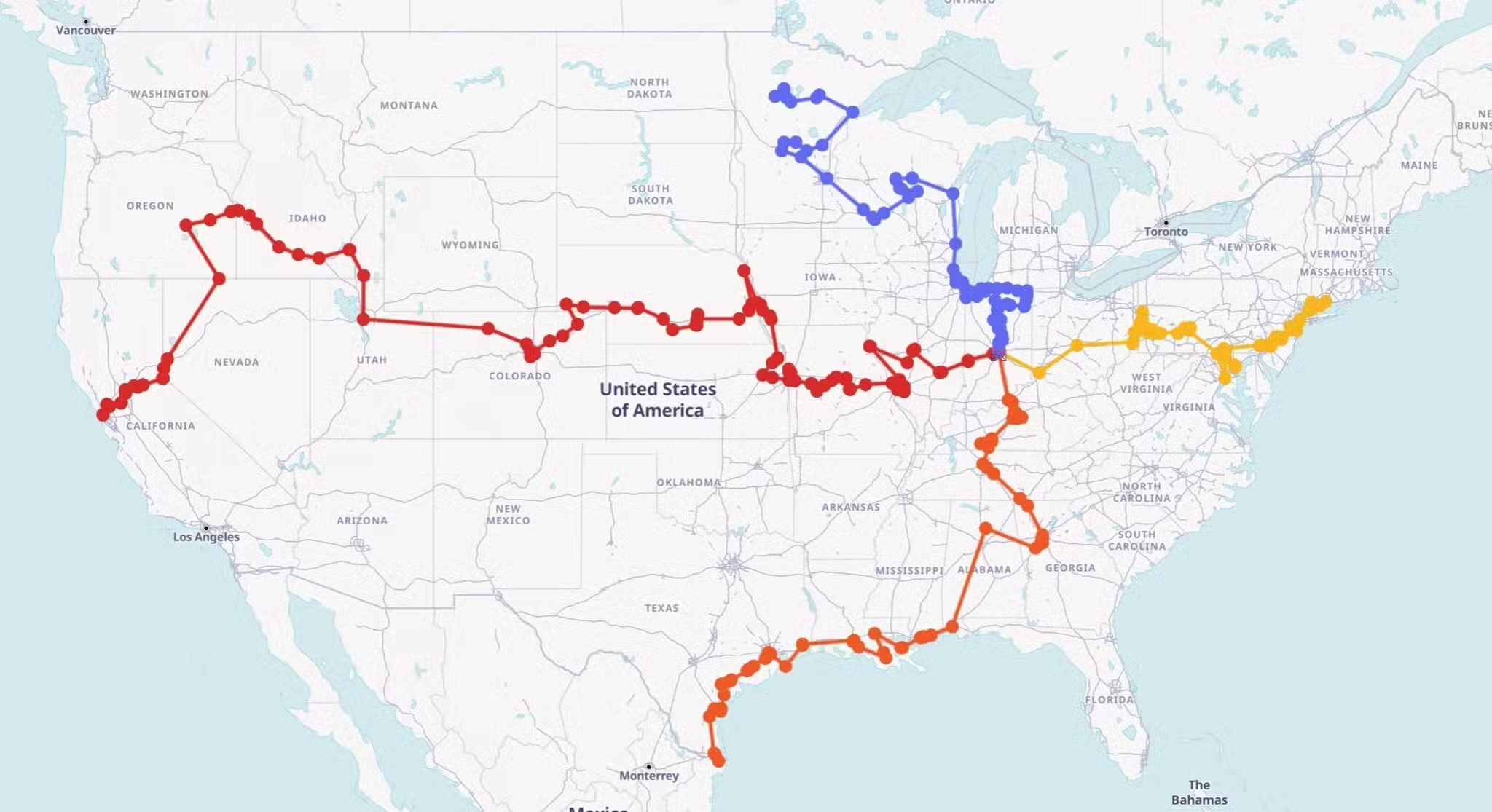
Eucharistic Pilgrimage kicks off May 18-19 with Masses, processions at iconic US sites

Enter, a Good Samaritan
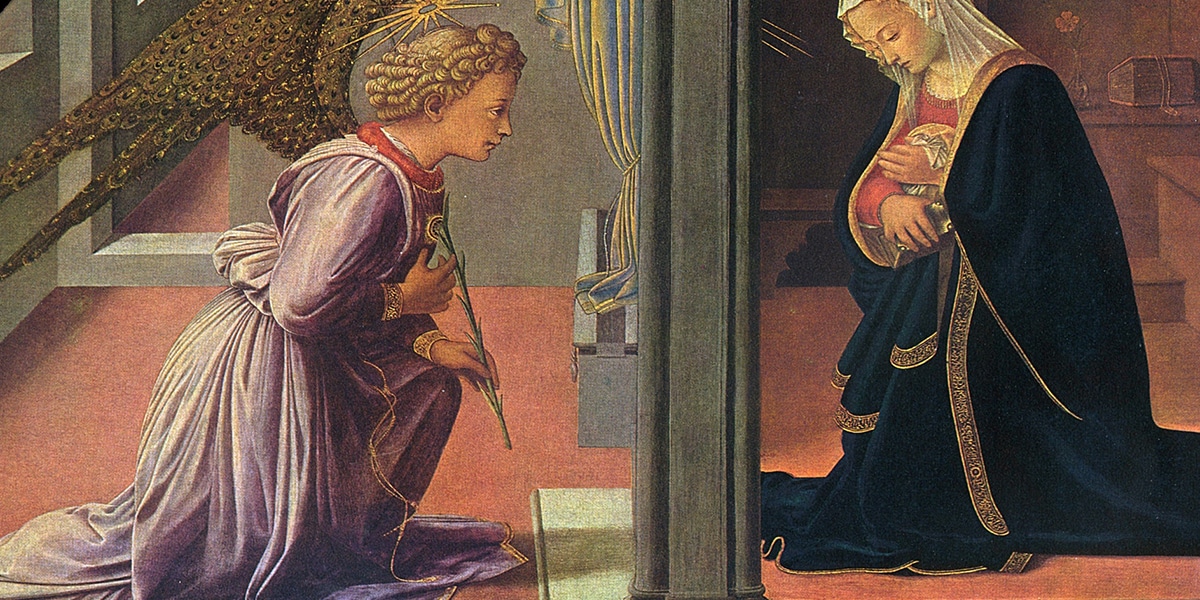
The Humble Handmaiden
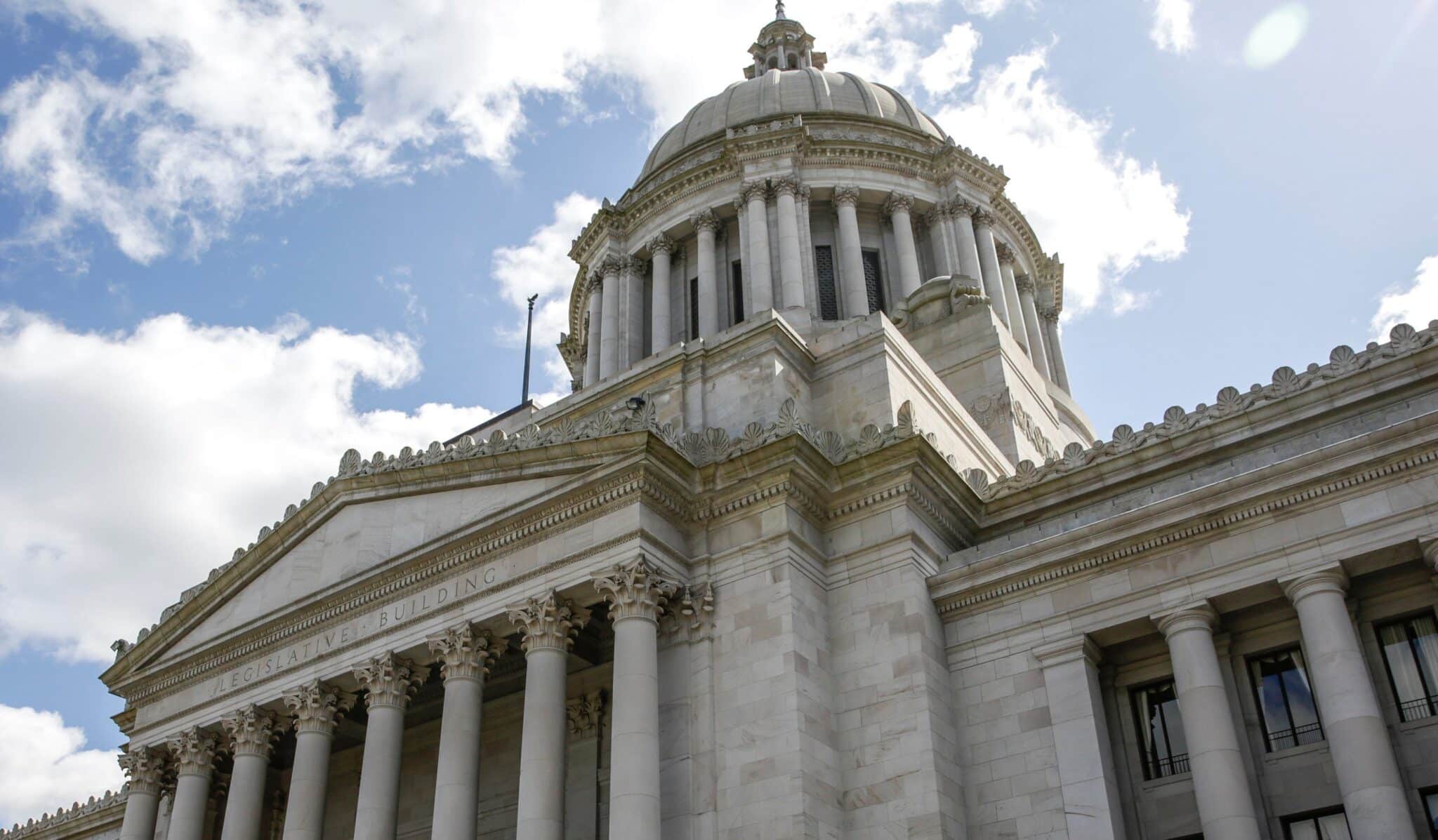
State attorney general investigates Washington’s dioceses over sex abuse response
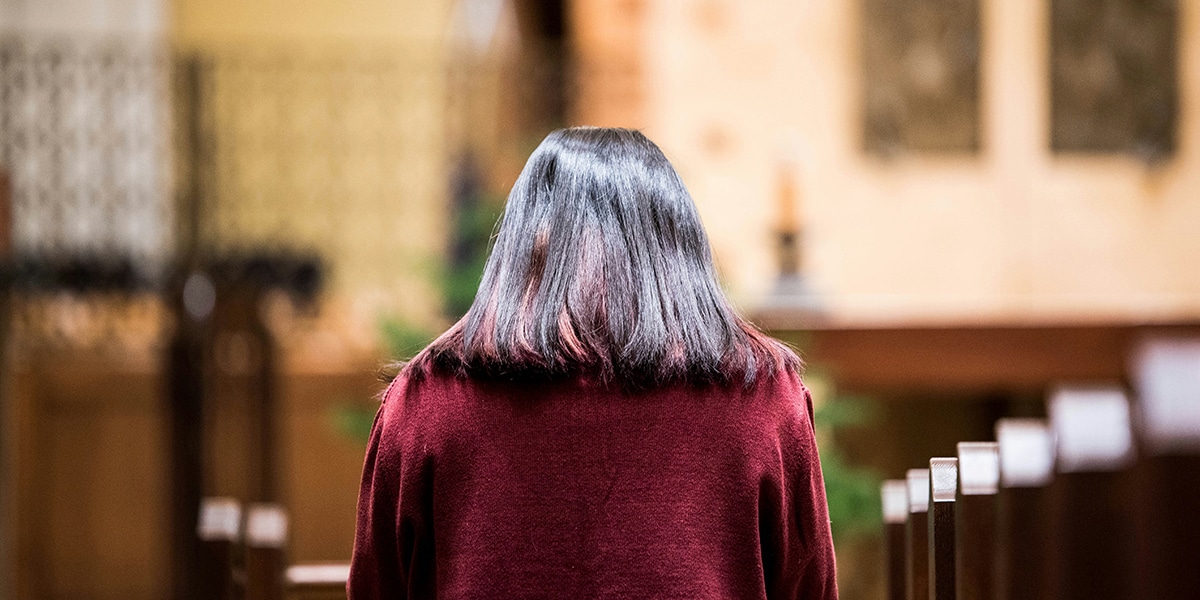
Filled with Grace

- Find Your Educational Consultant
- Review Our Catalogs
- Catholic Resources
- Saints Stories for All Ages
The Presentation of the Blessed Virgin Mary
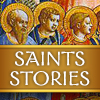
When Mary was asked to be the mother of the Savior, she was completely free to accept or reject the offer. Her response, “Let it be done to me,” was a great act of faith. Because she did not understand what was happening, she must have known that there would be difficulties ahead.
She replied yes to the angel's announcement and agreed to become the mother of Jesus, and the Church has declared Mary to be the Mother of God. Because she was the first to say yes to the Messiah, the Church has declared her to be the Mother of the Church.
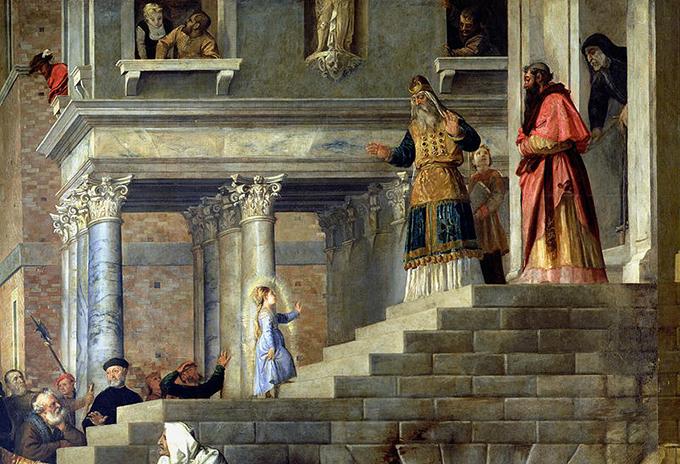
The feast of the presentation of Mary dates back to the 6th century in the East and the 15th century in the West. It is based on an ancient tradition that says Mary was taken to the temple in Jerusalem when she was 3-years-old and dedicated to God. What we celebrate on this day is the fact that God chose to dwell in Mary in a very special way. In response, Mary placed her whole self at the service of God. Every moment since your Baptism, God invites you to be open to his grace and dedicate yourself to him, as Mary did.
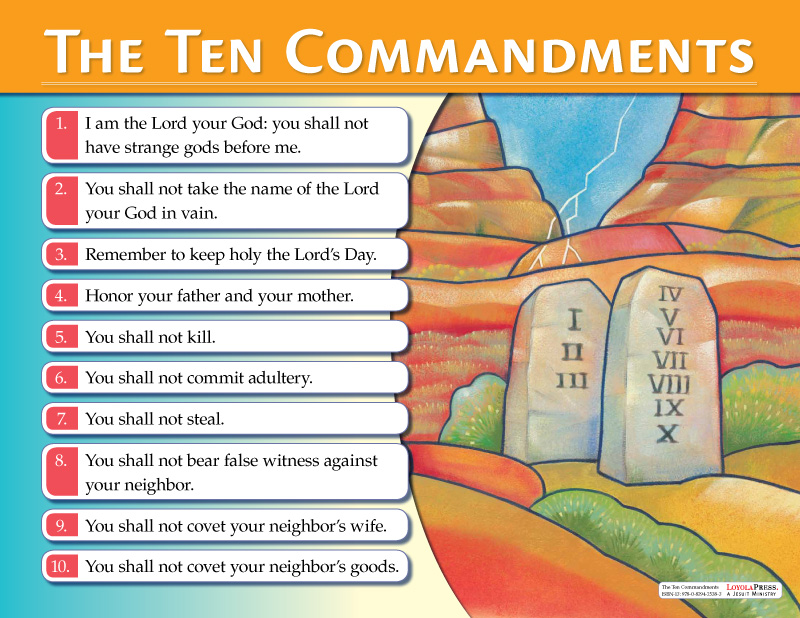
from Saints and Feast Days , by Sisters of Notre Dame of Chardon, Ohio
Image credit: Presentation of Mary by Titian, 1538. Public Domain via Wikimedia.
This Week's Stories
Lady julian of norwich, saint damien de veuster (martyr of molokai).
- Asia - Pacific
- Middle East - Africa
- Apologetics
- Benedict XVI
- Catholic Links
- Church Fathers
- Life & Family
- Liturgical Calendar
- Pope Francis
- CNA Newsletter
- Editors Service About Us Advertise Privacy

Feast of the Presentation of the Blessed Virgin Mary Feast day: Nov 21

Latest news
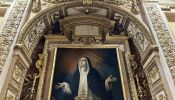
Discover the hidden chapel in Rome where St. Catherine of Siena died
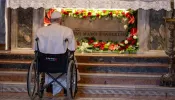
Pope Francis’ visit to Venice showcases art as means of encounter, fraternity

Pope Francis arrives in Venice, meets with women inmates and artists
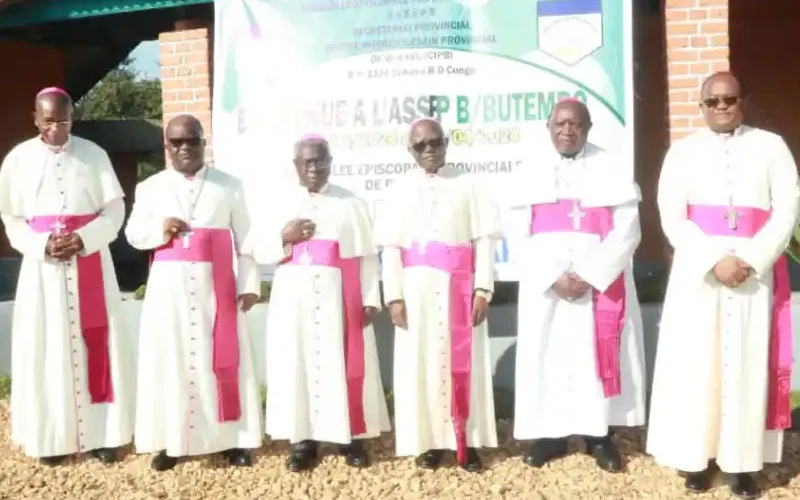
Democratic Republic of Congo bishops: Amid growth of Church ‘the Congolese state is dead’

Catholic movement in Italy dedicated to people ‘far from the Church’

Florida priest continued in active ministry for three years after sex abuse lawsuit filed
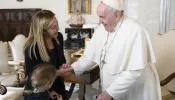
Pope Francis to attend G7 summit to speak on artificial intelligence

Pier Giorgio Frassati could be canonized during 2025 Jubilee, cardinal says

March for the Martyrs raises awareness of persecuted Armenian Christians and more
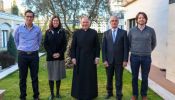
Presentation of the Blessed Virgin Mary
The Memorial of the Presentation of the Blessed Virgin Mary in the Temple recalls – according to the apocryphal gospels, the day on which Mary, while still a child, was brought to the temple in Jerusalem to be offered to God. The Church wants to emphasize not so much the historical event in itself, of which there is no trace in the Gospels, but the total gift that Mary made of herself, by listening: “ Blessed are those who hear the Word of God and observe it” (Lk. 11:28). This experience prepared the young girl from Nazareth to become the “temple of the Son of God”.
The celebration of this feast dates back to the 6 th century in the East with the dedication of the Basilica of Saint Mary the New built by the Emperor Justinian I near the ruins of the temple in Jerusalem. There is evidence that various monasteries in Italy celebrated the feast in the 9 th century. It was not until the 15 th century that it was included in the Roman Missal.
This is also the on which the Church celebrates the World Day of Cloistered Life, established by Pope Pius XII in 1953.
While he was still speaking to the people, behold, his mother and his brothers stood outside, asking to speak to him. But he replied to the man who told him, “Who is my mother, and who are my brothers?” And stretching out his hand toward his disciples, he said, “Here are my mother and my brothers! For whoever does the will of my Father in heaven is my brother, and sister, and mother”. (Mt. 12:46-50)
Bonds of love, not of blood
For the Memorial of the Presentation of the Blessed Virgin Mary, the liturgy proposes the passage from Matthew that speaks about how we are “related” to Jesus. It is a relationship not formed by blood, but by imitation: “ Whoever does the will of my Father in heaven is my brother, and sister, and mother”. To become a member of “His family”, one must do so not by blood or belonging to a particular religion. Rather, it is a free and personal choice that translates into a commitment to do the will of the Father.
Mary, the first disciple
Confirming what has just been said, Jesus Himself said this in responding thus to a woman who was praising His Mother: “ ‘ Blessed is the womb that carried you and the breasts at which you nursed.’ He replied, ‘Rather, blessed are those who hear the word of God and observe it.’ ” Mary is the woman who knows how to listen, who knows how to contemplate, who knows how to refer everything to her Son – “ Do whatever He tells you” (Jn. 2:5). Mary is the One who never abandoned her Son Jesus, not even along the way of the Cross. She “stood” under the Cross. She is a disciple who never abandons the Lord Jesus, who always “stands behind” Him.
Mary, model for Christians
All of this can help us imitate the Virgin Mary. Every Christian is called to look at Mary so as to learn from her, to entrust themselves to her intercession and to guard the “purity of the faith” against any idols that surround us.
Remember, O most gracious Virgin Mary, that never was it known that anyone who fled to thy protection, implored thy help, or sought thy intercession, was left unaided. Inspired by this confidence I fly unto thee, O Virgin of virgins, my Mother. To thee do I come, before thee I stand, sinful and sorrowful. O Mother of the Word Incarnate, despise not my petitions, but in thy mercy hear and answer me. Amen.

- liturgical year
More upcoming events:

Subscribe to our newsletters
To get the latest news

Santa Marta Mass

Papal audiences

Daily readings

Saint of the day

All prayers

The Feast of the Presentation
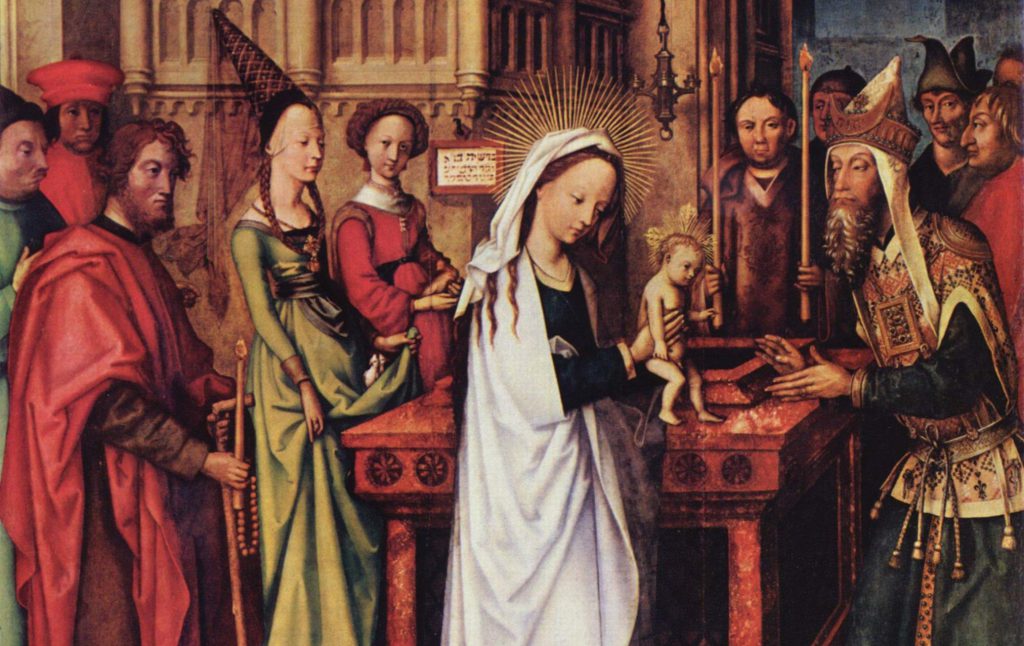
According to the Church’s liturgical calendar, the feast held on Feb. 2 each year is in honor of the Presentation of the Lord. Some Catholics recall this day as the feast of the Purification of the Blessed Virgin Mary because such was the feast day named until the 1969 changes in the Church’s calendar.
In fact, according to Luke’s Gospel, the presentation of Jesus and the purification of the Blessed Mother took place in the Temple on the same day, and both are remembered during Mass on Feb. 2. Also, in several countries, Candlemas is simultaneously celebrated on this day and involves a candlelight procession that was popularized in the Middle Ages. Until the Second Vatican Council the feasts on Feb. 2 ended the Christmas season. Today, the season ends in January on the feast of the Baptism of our Lord.
As early as the fourth century Christians commemorated the presentation of Jesus in the Temple, but, at the time, there was no feast name attached. In seventh-century Rome, the Church named the celebration the feast of the Purification of the Blessed Mother Mary, and it remained that way for nearly 1,300 years. In the reforms after Vatican II, the feast was given a stronger focus on Jesus (by stressing the Presentation of Jesus), but clearly the events of purification and presentation that took place when Jesus was 40 days old (see Lk 2:22-39) are tied together and thus commemorated together.
Purification and Presentation
Under Mosaic law found in the Old Testament Book of Leviticus, a Jewish woman who gave birth to a child was considered unclean (see 12:1-8). The mother of a newborn could not routinely go out into public and had to avoid all things sacred, including the Temple. If her child was a male, this exclusion lasted for 40 days. If the child was female, the period lasted 80 days. This was a ceremonial seclusion and not the result of sin or some kind of wrongdoing on the part of the mother.
At the end of the 40 or 80 days the woman presented herself at the Temple to be purified. If the baby was her firstborn male child, the infant was brought along to the Temple to be dedicated to the Lord. The law in Exodus specifies that the first male child belongs to God (see 13:2-16). This law is a tribute to God for His sparing the firstborn Israelite males during the time of the Exodus from Egypt. The firstborn Egyptian male children, of course, were not spared.
The mother’s purification ritual obliged her to bring, or purchase at the Temple, a lamb and a turtledove as sacrificial offerings. The lamb was offered in thanksgiving to God for the successful birth of the child; the turtledove was a sin offering. Families that could not afford a lamb could bring two pigeons or two turtledoves. After these animals were sacrificed, the Temple priest prayed over the woman and she could once again resume her normal role or status.
Mary, the ever spotless Mother of God, certainly did not have to comply with this ritual, but did so to honor God and observe all the rules handed down by Moses. She was the holiest of all women, but she still submitted to the humbling requirements of the law. She remained at home for 40 days, denied herself all association with sacred things and on the day required walked the five miles from Bethlehem to the Temple in Jerusalem. Arriving at the Temple, Mary likely stood in line and waited her turn to see the priest.
Nunc Dimittis
In Luke’s Gospel, Jesus, Mary and Joseph go to the Temple offering two turtledoves for Mary’s purification. Along with Mary’s willing submission, Jesus is presented into the hands of the priest and thus to God. In accordance with the Old Testament, the child was blessed and then bought or ransomed back by the family who would pay five shekels into the Temple treasury. The Savior of the world is ransomed in the manner of every other Hebrew boy. “When the days were completed for their purification according to the law of Moses, they took him up to Jerusalem to present him to the Lord, just as it is written in the law of the Lord, ‘Every male that opens the womb shall be consecrated to the Lord’”(Lk 2:22-24; see Nm 18:15-16).
The Gospel of Luke explains that the old prophet Simeon and the prophetess Anna were at the Temple that day (see 2:22-38). They, like many others, had spent their lifetime waiting, longing for a Messiah, and the Holy Spirit had revealed to Simeon that he would not die until he had seen the Savior. Among all the children and mothers coming into the Temple, Simeon recognized Jesus as the Christ Child; he held Jesus and exclaimed this hymn of thanksgiving, “Now, Master, you may let your servant go in peace, according to your word, for my eyes have seen your salvation, which you prepared in sight of all the peoples, a light for revelation to the Gentiles, and glory for your people Israel” (2:29-32). The hymn has traditionally been termed the Nunc Dimittis , from the Latin, “ Nunc dimittis servum tuum, Domine, secundum verbum tuum in pace .”
Like Mary, Jesus the Divine Son of God did not have to undergo these rituals, but His parents willingly complied in order to pay tribute to Jewish laws, to avoid any possible scandal and in so doing demonstrated profound humility. They acquiesced to the law like all poor Jewish families.
The Holy Family must have experienced great joy, even wonder at all that had happened to them. Consider the events of the previous weeks. First, the shepherds miraculously arrived to adore and praise Jesus on the night He was born. And now, Simeon, another stranger, singles out Jesus as the Savior, not only of Israel but of the world. Someday all the other children being presented will know Jesus as their Savior. But here in the Temple there is also pain. The old prophet, moved by the Holy Spirit, tells Mary that she will experience unspeakable grief because of the outrageous way the world would judge and treat her Son. But Mary remained always committed to God’s will and to her Son.
Feb. 2 is on the liturgical calendar as the feast of the Presentation of the Lord, but in addition to the presentation, the Mass recalls Mary’s humble submission to the purification ritual.
D.D. Emmons writes from O’Fallon, Ill.
You might also like...
Divine mercy sunday, embracing holy days.
Type on the field below and hit Enter/Return to search
The Presentation of the Blessed Virgin Mary
The Dedication of the Mother of God
Prisma/Getty Images
- Holy Days and Holidays
- Beliefs and Teachings
- Christianity Origins
- The New Testament
- The Old Testament
- Practical Tools for Christians
- Christian Life For Teens
- Christian Prayers
- Inspirational Bible Devotions
- Denominations of Christianity
- Christian Holidays
- Christian Entertainment
- Key Terms in Christianity
- Latter Day Saints
:max_bytes(150000):strip_icc():format(webp)/Scott-P.-Richert-58b30b155f9b5860469a4d22.jpg)
- M.A., Political Theory, Catholic University of America
- B.A., Political Theory, Michigan State University
The Presentation of the Blessed Virgin Mary, celebrated every year on November 21, commemorates (in the words of the Liturgy of the Hours, the daily prayer of the Roman Rite of the Catholic Church) "that dedication of herself which Mary made to God from her very childhood under the inspiration of the Holy Spirit who filled her with grace at her Immaculate Conception ." Also known as the Dedication of the Blessed Virgin Mary, the feast originated in the East, where it is called the Entry of the Most Holy Theotokos Into the Temple.
Quick Facts
- Date: November 21.
- Type of Feast: Memorial.
- Readings: Revelation 4:1-11; Psalm 150:1b-2, 3-4, 5-6; Luke 19:11-28 ( full text here )
- Prayers: The Hail Mary
- Other Names for the Feast: The Dedication of the Blessed Virgin Mary; The Presentation of Mary; The Entry of the Most Holy Theotokos Into the Temple
History of the Feast of the Presentation of the Blessed Virgin Mary
While the Presentation of the Blessed Virgin Mary was not generally celebrated in the West until the 11th century, it appears in most of the earliest calendars of the Eastern Churches. Derived from accounts in apocryphal literature, especially the Protoevangelium of James , the feast seems first to have appeared in Syria, where the Protoevangelium and other apocryphal books, such as the Infancy Gospel of Thomas and the Gospel of Pseudo-Matthew , originated. The Presentation of the Blessed Virgin Mary first rose to prominence, however, in Jerusalem, where it was associated with the dedication of the Basilica of Saint Mary the New.
That basilica was built near the ruins of the Temple in Jerusalem, and the Protoevangelium of James and other apocryphal works told the story of Mary's presentation at the Temple at the age of three. In gratitude for being granted a child after years of infertility, Mary's parents, Saints Joachim and Anna , had vowed to dedicate Mary to the service of God at the Temple. When they presented her at the Temple at the age of three, she stayed willingly, showing her dedication to God even at that young age.
The Presentation and the Protoevangelium of James
The Protoevangelium of James, while an extrabiblical document, is the source of many details of Mary's life that became universally accepted by the Church, including the names of her parents, the story of her birth , her age at her betrothal to Saint Joseph, and Saint Joseph's advanced age and his status as a widower with children by his first wife. It also played a large role among Christians, both Eastern and Western, in recognizing Mary as the new Temple, the true Holy of Holies. When Mary left the Temple at the age of 12 after her betrothal to Joseph, she remained pure and chaste, and at the Annunciation , God came to dwell in her.
The Spread of the Feast of the Presentation of the Blessed Virgin Mary
The Feast of the Presentation of the Blessed Virgin Mary first made its way to the West through monasteries in Southern Italy in the ninth century; by the 11th century, it had spread to other locales but was by no means universally celebrated. Under the influence of a French nobleman, Philippe de Mazières, Pope Gregory XI began celebrating the feast during the Avignon papacy.
Pope Sixtus IV first placed the Presentation of the Blessed Virgin Mary on the universal calendar in 1472, but in the Tridentine reform of the calendar in 1568, Pope Pius V removed the feast. It was restored 17 years later by Pope Sixtus V and remains in the Roman calendar today as a memorial.
- When Is the Virgin Mary's Birthday?
- The Visitation of the Blessed Virgin Mary
- How Long Did Jesus Live on Earth?
- Meditations on the Joyful Mysteries of the Rosary
- The Feast of the Presentation of the Lord
- Who Is the Virgin Mary?
- Holy Days of Obligation in the Catholic Church
- Prayers for May, the Month of the Virgin Mary
- The Feast of the Nativity of the Blessed Virgin Mary
- Holy Saturday
- Introduction to the Catholic Religion: Beliefs, Practices and History
- Is the Date of Easter Related to Passover?
- Mormon Trail of the Pioneers
- The Assumption of the Blessed Virgin Mary
- The Feast of the Immaculate Conception
- A Prayer to Saint Anne, Mother of Mary
- Privacy Policy
- Terms and Conditions
- Jobs in Singapore that you can do without a work permit
- How To Apply For A Job In Canada Through Express Entry
- Fruit Picking Jobs in Canada – Opportunities, Requirements, and Tips
- Canada Tourist Visa Requirements
- Getting Factory Jobs in Canada: A Comprehensive Guide
- A Guide on How to Land Caregiver Jobs For Yourself in Canada
- Don’t Miss This! Canada Jobs With Visa Sponsorship 2023 – 24 Apply Now
- Unlocking Opportunities: A Comprehensive Guide to MBA Scholarships
- Nurse Aide Jobs In UK Available: A Comprehensive Guide for Foreign Applicants
- Elderly Care Jobs in USA with Visa Sponsorship

History of the feast of Presentation of the Blessed Virgin Mary
Leave a comment 217 Views
On November 21, we celebrate the feast day of the presentation of the Blessed Virgin Mary . This is a special day to remember the blessed mother of Jesus and reflect on her life and role in the church.
The presentation of the Blessed Virgin Mary is a feast day that commemorates Mary’s presentation to the temple as a child. It is celebrated on November 21. This feast day is celebrated by many churches, and it has a long history dating back to the 6th century.
In this post, we’ll take a closer look at the history and meaning of the presentation of Blessed Virgin Mary feast day. We’ll also explore how it’s celebrated today and some of the traditions associated with it.
What Is the Presentation of the Blessed Virgin Mary?
It’s a feast day that commemorates when Mary was presented at the Temple in Jerusalem, and it’s usually celebrated on November 21st. It is also called The Entry of the Most Holy Theotokos into the Temple .
When Is It Celebrated?
You might be wondering when the presentation of the Virgin Mary is celebrated.
Well, the feast day is on November 21st. It’s a celebration that commemorates when Mary was presented to the Temple in Jerusalem. According to the book of apocryphal Protoevangelium of James, Mary’s parents (Joachim and Anna), who had been childless for many years, received a message from heaven that they would give birth to a child. In thanksgiving for the gift of their daughter Mary, they brought her, to the temple when she was still a child to consecrate her to God.
It was said that Mary was brought to the temple when she was just 3, in fulfillment of their vows to God.
Who Celebrates It?
The feast day is actually celebrated by the Catholic, Orthodox, and Anglican churches. And each denomination has its own unique way of celebrating this special day.
For Catholics, for example, the feast day is a time to celebrate Mary’s role as Mother of God. They often hold special Masses and prayer services to commemorate the occasion. And in many countries, it’s also a time for family gatherings and traditional food celebrations.
Anglicans commemorate the presentation of Mary as a model of obedience to God. They often hold church services and prayer meetings on this day. And like Catholics and Orthodox Christians, they also celebrate with traditional food celebrations and family gatherings.
The Origin of the Feast
The story of Mary’s presentation goes back to when she was still in her mother’s womb. Anna, Mary’s mother, had a dream in which she was told that her daughter would be the mother of the Messiah. When Anna gave birth to her daughter she and her husband Joachim, dedicated their child to God.
When Mary was three years old, her parents took her to the temple in Jerusalem to present her to the Lord. They offered sacrifices and prayed for their daughter.
Mary remained in the temple since when she was 3 till when she was 12 years old. Her father, St. Joachim, died when she was six, and her mother, St. Anne, died when she was eight. But even though she lost her parents at a young age, Mary continued to serve God with all her heart. She was later married by Joseph just before she turned fifteen. The feast of the Presentation of the Blessed Virgin Mary celebrates all that God has done for this special woman.
The presentation of our blessed Virgin Mary was first celebrated in Jerusalem, in a church that was built to honor the feast. At that time, the feast was popular in the East, and it wasn’t long before it caught on in other parts of the world.
It was introduced into the Papal Chapel in Avignon in 1372 by decree of Pope Gregory XI. The feast was later included in the Roman Missal in 1472 by him in 15 century and was later suppressed by Pope Pius V in mid 16 century as a result that, it did not appear in the Tridentine Calendar . But it was reestablished by Pope Sixtus V in 1585 and has been celebrated ever since.
The Presentation of the Blessed Virgin Mary is a Feast day that commemorates when Mary was presented to the Temple in Jerusalem. It is celebrated annually on November 21.
The Feast of the Presentation of the Blessed Virgin Mary is a very important day in the Catholic Church. It celebrates when Mary was presented to the Temple in Jerusalem by her parents, Joachim and Anna. According to tradition, Mary was consecrated to God and began her lifelong service in the Temple at the age of three.
The feast day is also celebrated in the Eastern Orthodox Church, where it is known as The Entry of the Most Holy Theotokos into the Temple.
The Presentation of the Blessed Virgin Mary is a solemn feast day that is celebrated with Mass and special prayers.
About Author
Ofomah stephen.
A content creator and Pro Blogger
See author's posts
- Apply now – Taxi Driver Urgently needed in USA free visa and Application
“Healthcare Careers: Jobs in the NHS and Beyond”
- Available Visa Sponsorship Caregiver Jobs in UK 2024 – Top Sponsorship Companies
- “Healthcare Careers in the Great White North”
- “Career Corners: Hot Industries for Jobs in the United States”
- 11 Best Canada MBA Scholarships for International Students
- “H1-B Visa Guide: Navigating the US Work Immigration Process”
- “Canada on a Budget: Affordable Travel Tips”
- Stumbleupon
Tags Catholic feasts Mary presentation of Mary St Anna St Joachim
Leave a Reply Cancel reply

What Language do Nigerians Speak: Major Languages Spoken in Nigeria


Georgian College International Scholarship in Canada

10 Canadian Jobs That Pay $500 – 1k$ Per Month With VISA Sponsorship

“Tech Boom: Landing a Job in Canada’s Silicon Valley”

The City’s Calling: Job Opportunities in London”

Legal Careers: Navigating the Law Job Market in the UK

Remote Work Revolution: How to Find Telecommuting Jobs in the US

In-Demand Skills: Finding Work in the United Kingdom

Green Jobs Revolution: Sustainable Careers in the United Kingdom

Catholic Daily Readings
Catholic readings, daily reflections, bible verse of the day, healing prayer, morning prayer, saint of the day, the presentation of the blessed virgin mary – feast day – november 21 2023, translate to your language, follow our whatsapp channel to get the daily mass readings on whatsapp.
Follow Our WhatsApp Channel to Get the Mass Readings Daily on Your WhatsApp Updates
Our feast today is known in the Western Roman Catholic Church as the Presentation of the Blessed Virgin Mary and in the Eastern Churches as the Entry of the Most Holy Theotokos into the Temple.
It is a Catholic Liturgical feast celebrated on November 21 every year.
This feast is not derived from the New Testament of the Holy Bible but from the Protoevangelium of James , which was discovered in the 2nd century AD.
In this writing, James says that Mary’s parents, Joachim and Anne , were old, and wealthy but childless. After much prayer and fasting, they received a message from heaven that they would be blessed with a child.
The couple were blessed with a daughter and named her Mary, and after three years, in thanksgiving , they consecrated her to God and took her to the temple of the Lord in Jerusalem and remained there. This was after they had made a vow to dedicate their child to God if they were blessed with one.
The Presentation of the Blessed Virgin Mary in the temple is likened to that of Samuel who was offered as a gift to God and presented to the temple by her mother Hannah, who was also barren.
Mary remained in the temple until she was 12 years when she was taken under the care of St Joseph . It is said that her father Joachim died when she was 6 years and her mother died when she was eight years old.
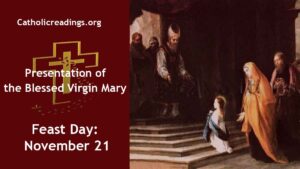
This feast of the Presentation of the Blessed Virgin Mary was first held in the Eastern Church around the 6th century but the Western Roman Catholic Church did not embrace it until the 15th century.
The feast started to be celebrated by the Byzantines after the dedication of the newly-built Basilica of Saint Mary in 543 AD in Jerusalem. However, the basilica was destroyed during the Siege of Jerusalem in 614 AD.
Even after the siege, the Eastern Church continued to celebrate the feast. In 1372, Pope Gregory XI introduced this feast to the Roman Catholic Church, and in 1472 it was included in the Roman Missal.
However, in 1568, Pope Pius V suppressed this feast but it was reintroduced in 1585 by Pope Sixtus V.
The feast of the Presentation of the Blessed Virgin Mary signifies the lifelong and total devotion that Mary made to God through her Immaculate Conception.
She listened to the voice of God while still in her childhood and agreed to become the temple of Jesus Christ, the Son of God .
Related Links
- Catholic Daily Readings for The Feast of the Presentation of the Lord, 2nd February 2020, Fourth Sunday in Ordinary Time, Year A – Sunday Homily
- Catholic Daily Mass Readings for February 2 2024, Friday, Feast of the Presentation of the Lord – Homily
- Presentation of the Lord at the Temple – Luke 2:22-40
- Bible Verse of the Day for April 2 2023 – Palm Sunday, Jesus Enters Jerusalem in Jubilation
- 2nd February 2019: Feast of the Presentation of the Lord Year C
Saints Whose Feast Days are in November
Powered By SEO Experts
Subscribe to Receive Catholic Daily Readings Via Email
Daily catholic readings app download, welcome to our catholic daily readings app installation page – download from google play store.
Copyright © 2024 | MH Magazine WordPress Theme by MH Themes


- Catholicism
- Religious Catalogue
- Give Monthly
- 1-800-447-3986
- [email protected]
- See of Peter
- Daily Mass and Readings
- Seasons and Feast Days
- Traditional Latin Mass
- Prayer Requests
- EWTN News Nightly
- EWTN Pro-Life Weekly
- EWTN News In Depth
- The World Over
- National Catholic Register
- Catholic News Agency
- Weekly Schedule
- Channel Finder
- Listen Live
- Audio Archive
- Monthly Schedules
- Podcast Central
- Galaxy 33 Transmission Plan
- SW Frequency Guide
- SW Monitoring Form
- Frequently Asked Questions
- EWTN Religious Catalogue
- My Giving Account
- Ways to Give
- Mother Angelica
- Online Learning Series
- EWTN Everywhere
- Media Missionaries
- Privacy Policy
- International Satellite Feeds
Why do Catholics celebrate the feast of the Presentation?
This feast day celebrates both the Presentation of Jesus in the Temple, as well as the Purification of Mary, which was required by the Mosaic Law forty days after the birth of a child.
The Church celebrates the feast of the Presentation of the Lord on February 2, also called Candlemas for the custom of using lighted candles. In the early Church it was often celebrated on February 14th, 40 days after the Epiphany, in keeping with the practice of celebrating Christmas on that date in the East. Among the Orthodox it is known as the Hypapante (“Meeting” of the Lord with Simeon).
DEEPEN YOUR UNDERSTANDING OF SACRED SCRIPTURE
Through this free ebook, the scriptural rosary: joyful mysteries ..
The Holy Rosary is an amazing prayer, encouraged by popes, loved by saints, and prayed by the faithful. Many miracles have come from this beautiful devotion. At its heart, the Rosary is a meditation on Sacred Scripture, on the lives of Jesus and Mary.
Through this Scriptural Rosary, we hope that you will be able to better meditate on each Hail Mary and deepen your understanding of Sacred Scripture. Use the form below to get your free copy of, The Scriptural Rosary .
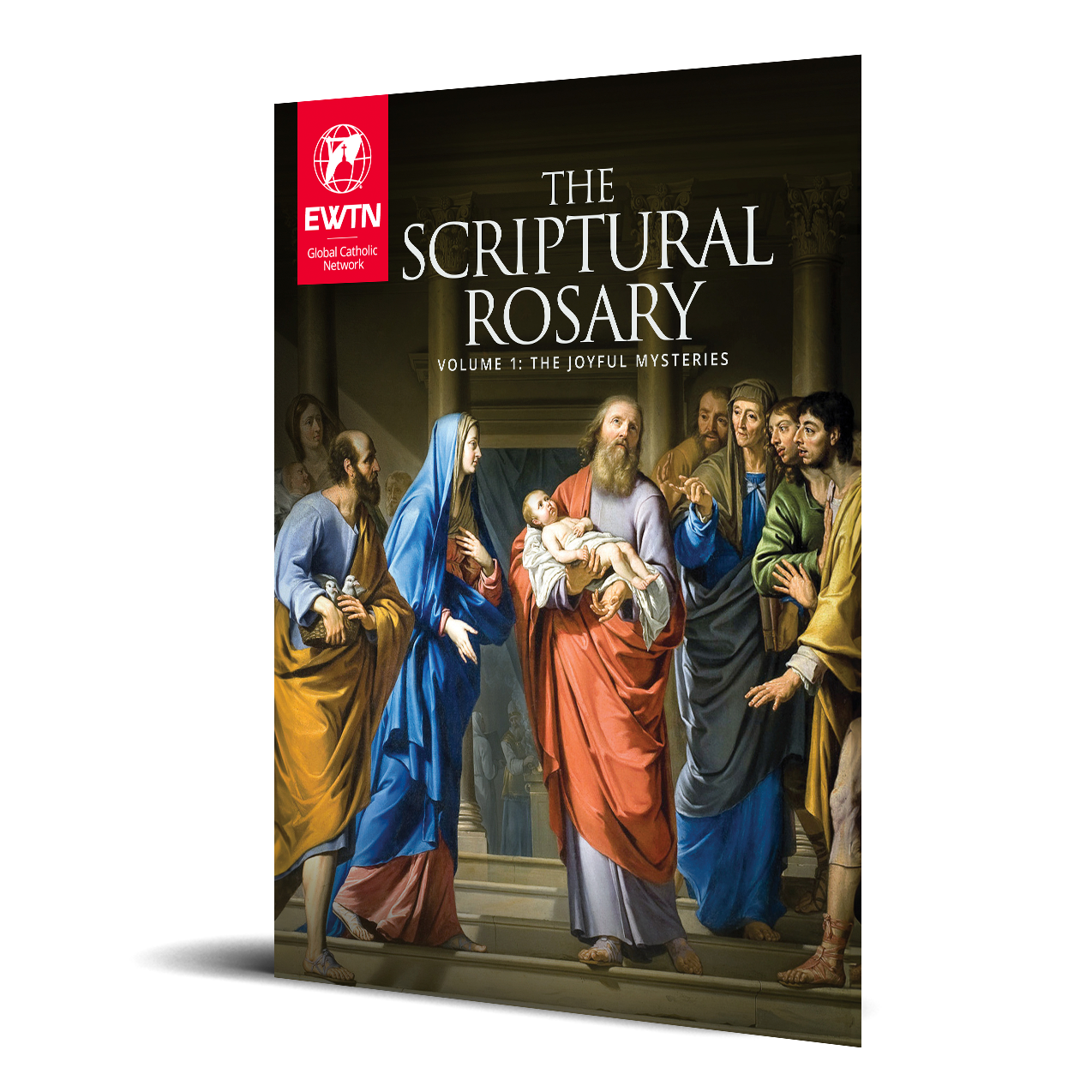
The Catechism of the Catholic Church (paragraph 529) teaches,
The presentation of Jesus in the temple shows him to be the firstborn Son who belongs to the Lord. With Simeon and Anna, all Israel awaits its encounter with the Savior-the name given to this event in the Byzantine tradition. Jesus is recognized as the long-expected Messiah, the “light to the nations” and the “glory of Israel,” but also “a sign that is spoken against.” The sword of sorrow predicted for Mary announces Christ's perfect and unique oblation on the cross that will impart the salvation God had “prepared in the presence of all peoples.”
It is also important to note that, as a poor family, the Holy Family gave an offering of a pair of turtledoves or two young pigeons. However, the Lamb whom they brought to the Temple was the Lamb of God.
He was presented when He was still a newborn, only 40 days old.
“In the mysterious encounter between Simeon and Mary, the Old and New Testaments are joined. Together the aging prophet and the young mother give thanks for this Light which has kept the darkness from prevailing. It is the Light which shines in the heart of human life: Christ, the Saviour and Redeemer of the world, ‘a light for revelation to the Gentiles and for the glory of his people Israel.’” – Pope St. John Paul II
The Gospel of Luke 2:22-40 states:
And when the time came for their purification according to the law of Moses, they brought him up to Jerusalem to present him to the Lord (as it is written in the law of the Lord, “Every male that opens the womb shall be called holy to the Lord”) and to offer a sacrifice according to what is said in the law of the Lord, “a pair of turtledoves, or two young pigeons.” Now there was a man in Jerusalem, whose name was Simeon, and this man was righteous and devout, looking for the consolation of Israel, and the Holy Spirit was upon him. And it had been revealed to him by the Holy Spirit that he should not see death before he had seen the Lord’s Christ. And inspired by the Spirit he came into the temple; and when the parents brought in the child Jesus, to do for him according to the custom of the law, he took him up in his arms and blessed God and said, “Lord, now lettest thou thy servant depart in peace, according to thy word; for mine eyes have seen thy salvation which thou hast prepared in the presence of all peoples, a light for revelation to the Gentiles, and for glory to thy people Israel.” And his father and his mother marveled at what was said about him; and Simeon blessed them and said to Mary his mother, “Behold, this child is set for the fall and rising of many in Israel, and for a sign that is spoken against (and a sword will pierce through your own soul also), that thoughts out of many hearts may be revealed.” And there was a prophetess, Anna, the daughter of Phanuel, of the tribe of Asher; she was of a great age, having lived with her husband seven years from her virginity, and as a widow till she was eighty-four. She did not depart from the temple, worshiping with fasting and prayer night and day. And coming up at that very hour she gave thanks to God, and spoke of him to all who were looking for the redemption of Jerusalem. And when they had performed everything according to the law of the Lord, they returned into Galilee, to their own city, Nazareth. And the child grew and became strong, filled with wisdom; and the favor of God was upon him.
Regarding Simeon and Anna, Pope Benedict XVI said,
Even the priests proved incapable of recognizing the signs of the new and special presence of the Messiah and Saviour. Alone two elderly people, Simeon and Anna, discover this great newness. Led by the Holy Spirit, in this Child they find the fulfilment of their long waiting and watchfulness. They both contemplate the light of God that comes to illuminate the world and their prophetic gaze is opened to the future in the proclamation of the Messiah: “Lumen ad revelationem gentium!” (Lk 2:32). The prophetic attitude of the two elderly people contains the entire Old Covenant which expresses the joy of the encounter with the Redeemer. Upon seeing the Child, Simeon and Anna understood that he was the Awaited One.
“… while we are still at the dawn of Jesus’ life, we are already oriented to Calvary. It is on the Cross that Jesus will be definitively confirmed as a sign of contradiction, and it is there that his Mother’s heart will be pierced by the sword of sorrow. We are told it all from the beginning, on the 40th day after Jesus’ birth, on the feast of the Presentation of Jesus in the Temple, so important in the Church’s liturgy.” - Pope St. John Paul II
This is a Hebrew name that means “he has heard” or “God has heard.”
When is St. Simeon’s feast day?
The Church celebrates his feast day on the day after Candlemas, February 3.
In Hebrew navi, a prophet is one who tells, a spokesperson of God, speaking divine truth, or foretelling what will be the consequences for the future. On both counts, Simeon was a prophet, who revealed the truth about who Jesus was, as well as the implications for Israel, for Jesus Himself and for Mary.
Originally taken from the Hebrew name Hannah, it means “favor” or “grace.”
When is St. Anna’s feast day?
Anna the Prophetess shares a feast day with St. Simeon on February 3.
“In the encounter between the old man Simeon and Mary, a young mother, the Old and New Testaments come together in a wondrous way in giving thanks for the gift of the light that shone in the darkness and has prevented it from prevailing: Christ the Lord.” - Pope Benedict XVI
St. Simeon offered this prayer,
Lord, now lettest thou thy servant depart in peace, according to thy word; for mine eyes have seen thy salvation which thou hast prepared in the presence of all peoples, a light for revelation to the Gentiles, and for glory to thy people Israel. (Luke 2:29-32)
Called the Nunc Dimittis, for the first words in the Latin Vulgate, it is one of the three major Canticles used in the Church’s liturgy. It is said each evening at the end of Night Prayer, the last Divine Office of the Liturgy of the Hours, or Breviary. The other Canticles are that of Zechariah, used for Lauds or Morning Prayer, and of Mary (the Magnificat), used for Vespers or Evening Prayer.
After speaking of Jesus, St. Simeon then spoke to Mary of her role of accompanying her Son in His redemptive suffering. Simeon reveals, as well, Mary’s own mission of intercession and compassion for us, her spiritual children.
Behold, this child is set for the fall and rising of many in Israel, and for a sign that is spoken against (and a sword will pierce through your own soul also), that thoughts out of many hearts may be revealed. (Luke 2:34-35)
“This is the meeting point of the two Testaments, Old and New. Jesus enters the ancient temple; he who is the new Temple of God: he comes to visit his people, thus bringing to fulfilment obedience to the Law and ushering in the last times of salvation.” - Pope Benedict XVI
Anna is the prophetess who saw the Holy Family at the Presentation of Jesus at the temple. The Gospel of Luke 2:36-38 tells us about Anna:
And there was a prophetess, Anna, the daughter of Phanuel, of the tribe of Asher; she was of a great age, having lived with her husband seven years from her virginity, and as a widow till she was eighty-four. She did not depart from the temple, worshiping with fasting and prayer night and day. And coming up at that very hour she gave thanks to God, and spoke of him to all who were looking for the redemption of Jerusalem.
The purification was ritual, preparatory to worship, in this case after the momentous events of childbirth and the time of rest or “laying in” afterwards. Thus, the Jewish priest purified himself by bathing before entering the holy place, and, similarly, the priest at Mass washes his hands before beginning the Eucharistic Prayer and handing the Body and Blood of Christ.
Mary, although morally pure, fulfilled her religious obligations by being purified 40 days after Jesus’ birth. Throughout her life, the Blessed Mother was always obedient to God’s Will, in this case expressed through the laws given to Israel through Moses.
“Simeon’s words seem like a second Annunciation to Mary, for they tell her of the actual historical situation in which the Son is to accomplish his mission, namely, in misunderstanding and sorrow. While this announcement on the one hand confirms her faith in the accomplishment of the divine promises of salvation, on the other hand it also reveals to her that she will have to live her obedience of faith in suffering, at the side of the suffering Savior, and that her motherhood will be mysterious and sorrowful.” — Pope St. John Paul II
This is the day when candles are blessed in the Church and traditionally have been lit in celebration of the feast.
Pope St. John Paul II said, “Christian traditions of the East and West have been interwoven, enriching the liturgy of this feast with a special procession in which the light of candles both large and small is a symbol of Christ, the true Light who came to illumine his people and all peoples.”
Candlemas is celebrated 40 days after Christmas. According to Leviticus 12, women should be purified 40 days after a son’s birth (33 days after the boy’s circumcision) and 80 days after a daughter’s birth. The purification was ritual, and preparatory to worship, in this case after the momentous events of childbirth and the time of rest or “laying in” afterwards.
In the Ordinary Form of the Latin Rite, the liturgical forms and calendar as revised after the Second Vatican Council, the last day of the Christmas Season is the Baptism of Our Lord, when His hidden life ended and His public ministry began.
However, the Church maintains an Extraordinary Form of the Latin Rite which utilizes the forms and calendar in use prior to the Council. In this usage, the Christmas Season continues until the Feast of the Presentation. Many Catholics, therefore, maintain their Christmas decorations through Candlemas.
Videos About Presentation of the Lord
Pope St. John Paul II said,
The prophetic words spoken by the aged Simeon shed light on the mission of the Child brought to the temple by his parents: “Behold this child is set for the fall and rising of many in Israel, and for a sign that is spoken against ... that thoughts out of many hearts may be revealed” (Lk 2:34-35). To Mary Simeon said: “And a sword will pierce through your own soul also” (Lk 2:35). The hymns of Bethlehem have now faded and the cross of Golgotha can already be glimpsed; this happens in the temple, the place where sacrifices are offered. The event we are commemorating today is thus a bridge as it were, linking the two most important seasons of the Church's year.
Pancakes are the traditional choice on Candlemas. In Mexico, people eat tamales on this feast day, and in France, they eat crepes.
What are the Joyful Mysteries of the Rosary?
The Joyful Mysteries include:
- The Annunciation
- The Visitation
- The Nativity of Our Lord
- The Presentation in the Temple
- The Finding of Jesus in the Temple
The Presentation is celebrated in the Church as the World Day for Consecrated Life. Pope St. John Paul II instituted this annual celebration in 1997 as a day of prayer for religious men and women and other consecrated persons. This recalls the special offering which they have made to the Lord through their vows of poverty, chastity and obedience. In Rome, the Holy Father celebrates a special Mass for them at St. Peter’s, which the religious living in Rome attend.
Pope Benedict XVI said,
The Presentation of Jesus in the Temple is an eloquent image of the total gift of one’s life for all those, men and women, who are called to represent “the characteristic features of Jesus — the chaste, poor and obedient one” (Post-Synodal Apostolic Exhortation, Vita Consecrata, n. 1) in the Church and in the world, through the evangelical counsels. For this reason Venerable John Paul II chose today’s Feast to celebrate the Annual World Day of Consecrated Life.


Is the Ascension a Holy Day of Obligation?
The answer is 'yes.' but do you have to go to mass that's more complicated..

Holy days of obligation stand as one of the more obvious examples, in ordinary Catholic experience, of the difference between doctrine and discipline.
That doesn’t mean that calendar changes are incapable of causing scandal or confusion among the faithful. Take Ascension Day as a prime example. Since the 1983 Code of Canon Law (CIC), bishops’ conferences have been permitted, with the approval of the Holy See, to direct the observance of weekday holy days to Sunday. This permission is different from an older practice of observing an “external solemnity”—repeating a weekday feast on the following Sunday for the benefit of the faithful—in that the canon simply allows the feast to be transferred. So, since at least 1999, most ecclesiastical provinces of the United States have moved Ascension Day to the Seventh Sunday of Easter.
So depending on where you go, today will either be Ascension Day or simply Thursday in the sixth week of Easter. For some Catholics , especially in the Northeast, in Nebraska, and in the Ordinariate, today is a holy day of obligation. For everyone else in the country, it isn’t.
There are two main aspects of this conundrum worth noting. First is the observance of holy days in general. Second is the transfer of holy days to Sunday.
On the first point, we should observe that the CIC for the Latin Church establishes ten days “of precept” in addition to all the Sundays of the year. In the United States, we have only six. (The Epiphany, Corpus Christi, St. Joseph, and Ss. Peter and Paul are left out). In Canada, there are only two (Christmas and Mary, Mother of God). Hawaii, interestingly, has permission to follow the Conference of the Pacific in obligating only Christmas and the Immaculate Conception.
The number of obligatory holy days, however, intertwines with the practice of transferal in that certain feast days that are formally excluded from the list are included by virtue of being moved to a Sunday: in our case, the Epiphany and Corpus Christi. (Side note: Various other feasts can also become obligatory by falling on a Sunday. For example, Candlemas, or the Presentation, is not usually a day of precept, but if February 2 falls on a Sunday, it outranks a Sunday in Ordinary Time and becomes, effectively, a solemnity of precept.)
Why, after many centuries of calendar stability, did the bishops decide to start moving major feasts days like the Epiphany, the Ascension, and Corpus Christi to Sunday? Most public explanations since the 1980s focus on that great favorite concept of the modern Church: “pastoral reasons.” But the actual practice is confusing and contradictory.
Take Canada, for example, where the Conference seems to think that making Catholics go to church on a non-Sunday is so burdensome that it can be done only a couple of times a year. But then if it is so very burdensome, it is not clear why the two holy days for the whole year have to be crammed into a single moment between December 25 and January 1—and, unlike in the U.S., the feast occurring on a Saturday or Monday doesn’t change the obligation.
The Epiphany now “is” the Sunday between January 2 and 8 in the United States, despite centuries of Catholic culture associating it with January 6 and despite the tradition of the twelve days of Christmas, Twelfth Night, Three Kings’ Day, etc. It is not entirely clear why it is burdensome to ask Catholics to go to Mass on January 6 but not burdensome for them to go to Mass on December 8.
One can be sympathetic with the removal of a burden —that is, making the feast day non-obligatory. After all, failing to attend Mass on a day of precept constitutes a grave sin if it is done consciously. I appreciate the pastoral desire to remove unnecessary obstacles to Catholics remaining in a state of grace! Indeed, Ash Wednesday is perhaps the most obvious proof that a day does not need to be obligatory to be popular or well attended.
But it is, I submit, a rather different thing to declare that, since the faithful are unlikely (or unable, or unwilling) to attend Mass during the week, we must therefore fiddle with the calendar in a way that throws centuries of Catholic devotional and popular culture out the window. In fact, it’s not just “traditional” culture that gets lost. Take Ascension Day, which in most places replaces the Seventh Sunday of Easter. The framers of the new lectionary for the 1970 Missal gave us the same gospel reading from John for all three years on that Sunday; clearly, they thought the faithful ought to hear Jesus’ high priestly prayer in John 17 that we all be one as he and the Father are one. But most Catholics never hear that reading at Mass because it is replaced by the Mass for the Ascension. Similarly, the removal of the Epiphany from January 6 to Sunday usually causes us to miss the Feast of the Baptism of the Lord—or rather, it gets moved to a weekday, where it is usually forgotten. And by the way, St. Peter’s Basilica in Rome, hardly what we would call “rigid” these days on liturgical matters, has continued to keep all of these feasts on their proper dates.
I do not doubt the authority of the bishops, or of the Holy See, to approve these calendar adaptations. You’re not going to see me rebelliously purporting to celebrate Corpus Christi on the Thursday after Trinity Sunday. Still, I think it’s high time we recognize that the “pastoral” tinkering with the calendar in recent decades has served only to further dilute the experience of a common Catholic culture. A more robust observance of the calendar doesn’t have to be hard (or even obligatory). I think the more “pastoral” solution would be for the bishops to allow the faithful to receive the gift of the calendar as the Church has handed it down.
More from Catholic.com
- Yekaterinburg
- Novosibirsk
- Vladivostok

- Tours to Russia
- Practicalities
- Russia in Lists
Rusmania • Deep into Russia
Out of the Centre
Savvino-storozhevsky monastery and museum.

Zvenigorod's most famous sight is the Savvino-Storozhevsky Monastery, which was founded in 1398 by the monk Savva from the Troitse-Sergieva Lavra, at the invitation and with the support of Prince Yury Dmitrievich of Zvenigorod. Savva was later canonised as St Sabbas (Savva) of Storozhev. The monastery late flourished under the reign of Tsar Alexis, who chose the monastery as his family church and often went on pilgrimage there and made lots of donations to it. Most of the monastery’s buildings date from this time. The monastery is heavily fortified with thick walls and six towers, the most impressive of which is the Krasny Tower which also serves as the eastern entrance. The monastery was closed in 1918 and only reopened in 1995. In 1998 Patriarch Alexius II took part in a service to return the relics of St Sabbas to the monastery. Today the monastery has the status of a stauropegic monastery, which is second in status to a lavra. In addition to being a working monastery, it also holds the Zvenigorod Historical, Architectural and Art Museum.
Belfry and Neighbouring Churches

Located near the main entrance is the monastery's belfry which is perhaps the calling card of the monastery due to its uniqueness. It was built in the 1650s and the St Sergius of Radonezh’s Church was opened on the middle tier in the mid-17th century, although it was originally dedicated to the Trinity. The belfry's 35-tonne Great Bladgovestny Bell fell in 1941 and was only restored and returned in 2003. Attached to the belfry is a large refectory and the Transfiguration Church, both of which were built on the orders of Tsar Alexis in the 1650s.

To the left of the belfry is another, smaller, refectory which is attached to the Trinity Gate-Church, which was also constructed in the 1650s on the orders of Tsar Alexis who made it his own family church. The church is elaborately decorated with colourful trims and underneath the archway is a beautiful 19th century fresco.
Nativity of Virgin Mary Cathedral

The Nativity of Virgin Mary Cathedral is the oldest building in the monastery and among the oldest buildings in the Moscow Region. It was built between 1404 and 1405 during the lifetime of St Sabbas and using the funds of Prince Yury of Zvenigorod. The white-stone cathedral is a standard four-pillar design with a single golden dome. After the death of St Sabbas he was interred in the cathedral and a new altar dedicated to him was added.

Under the reign of Tsar Alexis the cathedral was decorated with frescoes by Stepan Ryazanets, some of which remain today. Tsar Alexis also presented the cathedral with a five-tier iconostasis, the top row of icons have been preserved.
Tsaritsa's Chambers

The Nativity of Virgin Mary Cathedral is located between the Tsaritsa's Chambers of the left and the Palace of Tsar Alexis on the right. The Tsaritsa's Chambers were built in the mid-17th century for the wife of Tsar Alexey - Tsaritsa Maria Ilinichna Miloskavskaya. The design of the building is influenced by the ancient Russian architectural style. Is prettier than the Tsar's chambers opposite, being red in colour with elaborately decorated window frames and entrance.

At present the Tsaritsa's Chambers houses the Zvenigorod Historical, Architectural and Art Museum. Among its displays is an accurate recreation of the interior of a noble lady's chambers including furniture, decorations and a decorated tiled oven, and an exhibition on the history of Zvenigorod and the monastery.
Palace of Tsar Alexis

The Palace of Tsar Alexis was built in the 1650s and is now one of the best surviving examples of non-religious architecture of that era. It was built especially for Tsar Alexis who often visited the monastery on religious pilgrimages. Its most striking feature is its pretty row of nine chimney spouts which resemble towers.

Plan your next trip to Russia
Ready-to-book tours.
Your holiday in Russia starts here. Choose and book your tour to Russia.
The Unique Burial of a Child of Early Scythian Time at the Cemetery of Saryg-Bulun (Tuva)
<< Previous page
Pages: 379-406
In 1988, the Tuvan Archaeological Expedition (led by M. E. Kilunovskaya and V. A. Semenov) discovered a unique burial of the early Iron Age at Saryg-Bulun in Central Tuva. There are two burial mounds of the Aldy-Bel culture dated by 7th century BC. Within the barrows, which adjoined one another, forming a figure-of-eight, there were discovered 7 burials, from which a representative collection of artifacts was recovered. Burial 5 was the most unique, it was found in a coffin made of a larch trunk, with a tightly closed lid. Due to the preservative properties of larch and lack of air access, the coffin contained a well-preserved mummy of a child with an accompanying set of grave goods. The interred individual retained the skin on his face and had a leather headdress painted with red pigment and a coat, sewn from jerboa fur. The coat was belted with a leather belt with bronze ornaments and buckles. Besides that, a leather quiver with arrows with the shafts decorated with painted ornaments, fully preserved battle pick and a bow were buried in the coffin. Unexpectedly, the full-genomic analysis, showed that the individual was female. This fact opens a new aspect in the study of the social history of the Scythian society and perhaps brings us back to the myth of the Amazons, discussed by Herodotus. Of course, this discovery is unique in its preservation for the Scythian culture of Tuva and requires careful study and conservation.
Keywords: Tuva, Early Iron Age, early Scythian period, Aldy-Bel culture, barrow, burial in the coffin, mummy, full genome sequencing, aDNA
Information about authors: Marina Kilunovskaya (Saint Petersburg, Russian Federation). Candidate of Historical Sciences. Institute for the History of Material Culture of the Russian Academy of Sciences. Dvortsovaya Emb., 18, Saint Petersburg, 191186, Russian Federation E-mail: [email protected] Vladimir Semenov (Saint Petersburg, Russian Federation). Candidate of Historical Sciences. Institute for the History of Material Culture of the Russian Academy of Sciences. Dvortsovaya Emb., 18, Saint Petersburg, 191186, Russian Federation E-mail: [email protected] Varvara Busova (Moscow, Russian Federation). (Saint Petersburg, Russian Federation). Institute for the History of Material Culture of the Russian Academy of Sciences. Dvortsovaya Emb., 18, Saint Petersburg, 191186, Russian Federation E-mail: [email protected] Kharis Mustafin (Moscow, Russian Federation). Candidate of Technical Sciences. Moscow Institute of Physics and Technology. Institutsky Lane, 9, Dolgoprudny, 141701, Moscow Oblast, Russian Federation E-mail: [email protected] Irina Alborova (Moscow, Russian Federation). Candidate of Biological Sciences. Moscow Institute of Physics and Technology. Institutsky Lane, 9, Dolgoprudny, 141701, Moscow Oblast, Russian Federation E-mail: [email protected] Alina Matzvai (Moscow, Russian Federation). Moscow Institute of Physics and Technology. Institutsky Lane, 9, Dolgoprudny, 141701, Moscow Oblast, Russian Federation E-mail: [email protected]
Shopping Cart Items: 0 Cart Total: 0,00 € place your order
Price pdf version
student - 2,75 € individual - 3,00 € institutional - 7,00 €

Copyright В© 1999-2022. Stratum Publishing House
- Principal's Message
- Co-Education
- Catholic Identity
- Social Justice
- Our History and Tradition
- EREA Governance
- Child Safeguarding
- Learning Programs
- Co-Curricular Programs
- Careers Development
- Learning Diversity
- Student Wellbeing
- Enrolment Procedure
Apply Today
- Contact Us About An Enrolment
- College Tours
- Scholarships
- Access & Transport
- Calendar & Events
- College News
- Parents & Friends
- Book a Tour
Talk and Tours
Request a Prospectus
Connect with us
2024 lumina edition 6, 10 may 2024, happy mother's day.
When our mothers are tired, Lord, give them strength.
When our mothers are tired, Lord, give them strength.
When they feel alone, give them comfort.
When they feel overwhelmed with the challenges of parenting, help them to know peace.
In their darkest moments, be their Light.
At times in our lives, our mothers are everything to us, meeting our every need.
We ask You to provide them today with whatever gift they need.
In gratitude for all Mothers, we pray.
There was a great energy with the whole school community on the Edmund Rice Campus for the day that further reinforces my sense of optimism about our future on a single campus.
Darren atkinson.
College Principal
St Mary’s College acknowledged the Feast Day of Blessed Edmund Rice on Monday, 6th May
Feast Day of Blessed Edmund Rice
Edmund Rice, founder of the Christian Brothers, was born in Ireland in 1762. We know very little of his childhood but celebrate his life and the contribution he made to education of young people on May 5th each year. St Mary’s College acknowledged the Feast Day of Blessed Edmund Rice on Monday, 6th May and it was a day of great celebration. As my first experience of our feast day, I was impressed by the generosity of spirit on demonstration during the day. I especially appreciated the way the audience supported our “masked singers” who took a risk and performed in front of their peers. The audience response showed that we want others to feel safe in our community and this is admirable. There was a great energy with the whole school community on the Edmund Rice Campus for the day that further reinforces my sense of optimism about our future on a single campus.
Thanks to Mr Lancashire who planned our liturgy so that we could thank God for the many blessings we receive in an Edmund Rice school and Ms Lawless and our singers who assisted with music. Thanks also to Ms Saundry and staff helpers who ensured that we were well fed. I hope everyone had great fun.
Mother’s Day Breakfast
We said thanks to our mothers on Thursday morning at our annual Mother’s Day Breakfast with about 80 in attendance. In taking a moment to thank our mothers, we acknowledged their invaluable role as the first educators and appreciate that we are indeed privileged to be able to partner in the formation of our young people. It is also important that we remember that our families look different, and that the mothering role is sometimes undertaken by a grandparent, or an aunt, or friend. We give thanks to those who nurture our young people and show us what it means to live with love and compassion. Thank you to the parents who were able to be present, Sandie Saundry, Avril Martinelli, David Formosa, our P&F, and our student leaders for facilitating this celebration of motherhood. Happy Mother’s Day for Sunday.
Time and Space Workshops
The second of our Time and Space Workshops for Year 7 students occurred on Tuesday night and I want to say thank you to those who were able to attend and spend some special time together. The feedback from both our Year 7 and Year 8 evening reflects the value in setting aside time in our busy lives to talk and find out a bit more about our young people and for our young people to also learn something new about their guardians.
This was typical of the feedback from parents: “Thank you for this gift of time, to sit still and be present.”
And from one of the students: “It was a really good discussion with my mum, since we got some alone time to talk about ourselves… it was really fun as we all got to express our feelings to one another.”
Thanks to Ms Howard, Director of Students, and the staff who attended each night and to our amazing student and parent helpers.
Enrolment in Year 7 2025
We continue to meet families who tell us that they were previously unaware of St Mary’s College and are pleased to have found a Catholic co-educational school in our part of Melbourne. We’ve been able to reassure most that we are rebuilding and, as such, that it is not too late to get a place for 2025. In many cases it was on the recommendation of a family member, friend or associate that led to the enquiry, and I ask for your assistance in spreading the word about our great school. The power of a personal recommendation from you is invaluable. In the meantime, we will continue to get word out and are offering a Talk and Tour, led by our student ambassadors, each week and these are proving very popular.
$400 School Saving Bonus
This week the Allan Labor Government announced a $400 School Saving Bonus for all school students in government schools regardless of income, but only for Health Care Card holders in Catholic schools. This is deeply unfair. Families in Catholic schools are also experiencing cost of living pressures and this announcement discriminates against your family.
We believe the payment should be means tested for all students or apply to all students. It should not be based on which school you attend, and it punishes families for choosing to send their children to a Catholic school.
Our school, EREA and the peak body, the Victorian Catholic Education Authority, wish to oppose this policy and we need your help. Please consider contacting your local Member of Parliament to express your concern.
Darren Atkinson College Principal
A school community committed to continuous improvement.
Shaun lancashire.
Deputy Principal
When St Mary’s College commenced at the beginning of the 2021 school year, it was identified that a concerted effort would be required to shape the newly co-educational school
When St Mary’s College commenced at the beginning of the 2021 school year, it was identified that a concerted effort would be required to shape the newly co-educational school and its culture, so that girls and boys, many of whom attended single sex schools previously, learned to live and work together over time. It was clear then, as it is clear now, that this is not an ideal that can at any stage be considered ‘accomplished’. It is an ongoing action, part of what we do, explicitly and frequently addressed, rather than something we will consider ‘done’. The work that takes place in pursuit of this being part of our culture is the way it continues to be part of who we are.
It is a certainty that bringing daily and enduring harmony to any school community, let alone one that is still considered ‘newly’ co-ed, has its challenges. Perfection is not what we are seeking. A school community committed to continuous improvement, particularly in the area of gender relations and respectful relationships is the intent. In light of recent media reports calling into question the way that schools might, could, or should deal with issues of this nature, I thought it might be helpful to provide some thoughts on just some of the work we have undertaken in recent years, and which we continue to do with our staff and students.
The College partnered with Latrobe University in 2021 by inviting one of their academics Leanne Higham, who was an author of the Department of Education respectful relationships program, into dialogue with our staff around the issue of unconscious bias. This was a source or reflection for staff who had previously been working in a single sex environment. This partnership continues to this day, with Leanne and her colleagues conducting a cultural research project in the college focused on our move to becoming a co-educational school.
Our students are engaged in a range of lessons selected and built upon using the respectful relationships program. We are a certified respectful relationships ‘partner school’ and have amassed a wealth of resources and age-appropriate lessons which are delivered fortnigfhtly to every student in the school. In recent weeks, I made a clear and concise presentation to each year level group on the issue of bullying in all its forms. There are some simple, yet powerful elements to this presentation, in particular gender-based conflict and language. Staff and students often reference elements of what was covered in this presentation when required. All of this work is in pursuit of continuous improvement and adherence to the child safe standards of Victoria.
Walkathon 2024
In recent days, each student has been provided their unique walkathon donation code via an email they received from the college. This is the major fundraising campaign for the year, with a minimum of $50 per student being our target. We have spent time with our students explaining the purpose of our walkathon and where the money they raise will go. We have taken time to unpack the Catholic social teaching principals, such as providing preferential treatment for the poor by advocating for them and standing in solidarity with them. There is great purpose and educational value to the walkathon and its place in our calendar. It is important that we have the support of all families with the fundraising effort and attendance on the day, for the benefit of the community you are part of.
Shaun Lancashire Deputy Principal
Director of Identity
This week I have taken on the responsibility of the Director of Identity at St Mary’s College.
Life is not something we rush.
This week I have taken on the responsibility of the Director of Identity at St Mary’s College. As an existing staff member, I have met many members of our community.
As we continue to celebrate the Easter season until the feast of Pentecost it is worth taking some time to reflect on the 50 days of the season.
In the liturgical year only ordinary time is longer than Easter. The time to celebrate new life is not something we rush. We do not return to the ordinary after something so extraordinary.
In the northern hemisphere the melting of snow and the green shoots that emerge are matched by longer days and the retreat of night. The palpable sense of life bursting forth all around is not our experience in the southern hemisphere.
We need to take our fallen leaves, rake them into a pile and enjoy the work of composting that ultimately renews the soil.
In a world that rushes as a matter of course, the longer processes of new life that we experience might have a lesson for us.
The renewal of the soil mirrors our spiritual renewal. Quietly done, less than obvious but ultimately the source of all life.
At St Mary’s we hope to take this time with our students, parents, staff and supporters. Inspired by Mary, who endured all that Holy Week and Good Friday brought to her, we share in the glory of Easter.
Paul Quinn Director of Identity
Year 8 College Leaders
Director of Students
No longer the youngest members of our school community, our Y8 students have established themselves well at the Edmund Rice Campus.
Like with all our Class Captains, our Y8s demonstrated their desire and drive to lead their peers through the submission of excellent application letters and recommendations from friends and teachers. Our Y8s have many exciting ideas and aspirations for the 2024 academic year.
Please join me in congratulating our Y8 Class Captains.
Zac Lucas (8T)
Zac would like to help students, especially new ones, to make friends at the College.
Ojiro Sato (8C)
This year, Ojiro would like to create better relationships between students and their teachers.
Charles Couch (8T)
Charles would like to help students in his homeroom with learning, specifically Maths.
Sophie Hoad (8R) – absent (attending Y8 camp)
This year, Sophie is keen to make improvements to the school through participation in Student Voice
Jen Howard Director of Students
Using their newfound knowledge, students meticulously reproduced these binary sequences onto bracelets.
David formosa.
Director of Development
In our Year 7 Digitech classes, students have been diving into the fascinating world of binary code.
Exploring Binary Code in Year 7 Digitech Classes!
In our Year 7 Digitech classes, students have been diving into the fascinating world of binary code. This foundational concept in computer science forms the backbone of digital communication and computing systems.
As part of their exploration, students recently engaged in a hands-on activity that brought binary code to life in a creative and meaningful way. In preparation for Mother's Day, students had the opportunity to translate heartfelt messages, such as "Love you, Mum" and "Thank you for everything," into binary code.
Using their newfound knowledge, students meticulously reproduced these binary sequences onto bracelets, transforming them into unique and personalised gifts for their mothers. Each bracelet became a wearable symbol of appreciation and affection, encoded in the language of computers.
As our Year 7 students continue their journey in Digitech classes, we look forward to further exploration and discovery in the realm of digital technology. Stay tuned for more exciting updates on their learning adventures!
David Formosa Director of Development

Save the Date
Co Chair Parents and Friends
You won't want to miss this event. 80's v 90's Trivia Night

NCCD Funding Fact Sheet
Chris sodaitis.
Learning Diversity Coordinator
NCCD Funding Fact Sheets
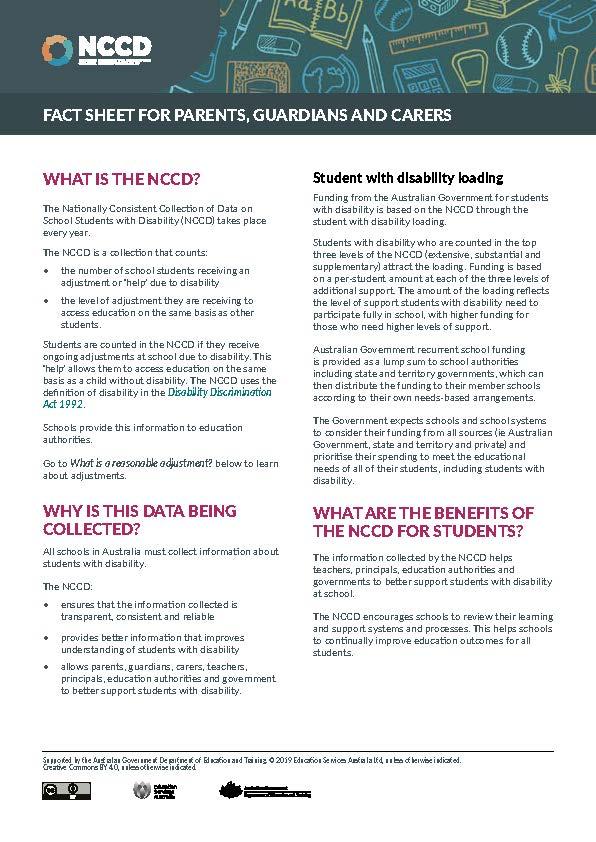
The ACC Art and Technology Exhibition is coming up ....
Raoul chapman.
Learning Leader VAPA
The ACC Art and Technology Exhibition is coming up and we have 20 current and past students exhibiting their work.
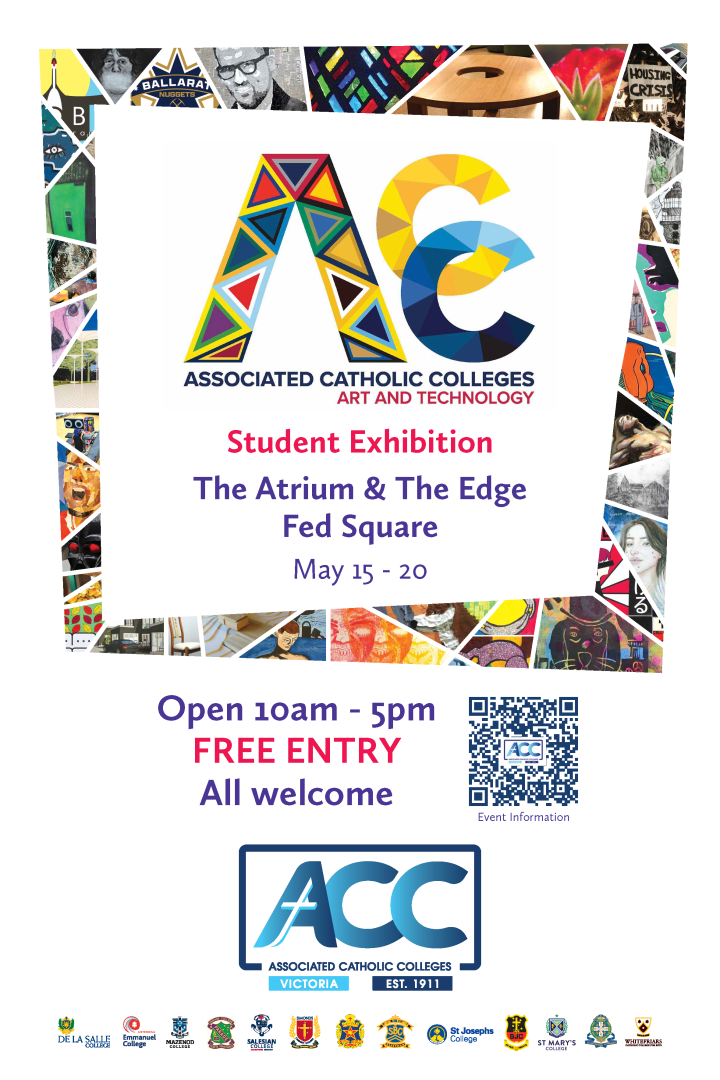
Charter Renewal and Mission Strategy Open Forum Invitation
EREA is re-imagining who we are and how we work as an authentic Catholic school in the Edmund Rice tradition.
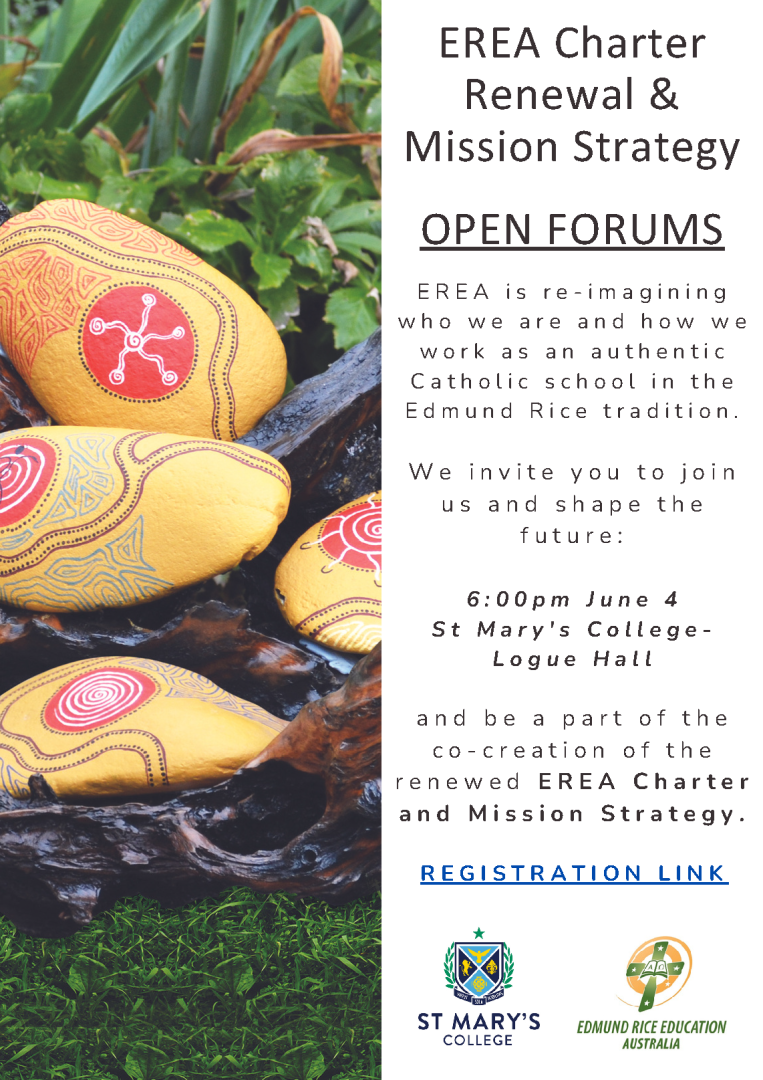
REGISTRATION LINK
Fortnight in Photos
Capturing our school in images.
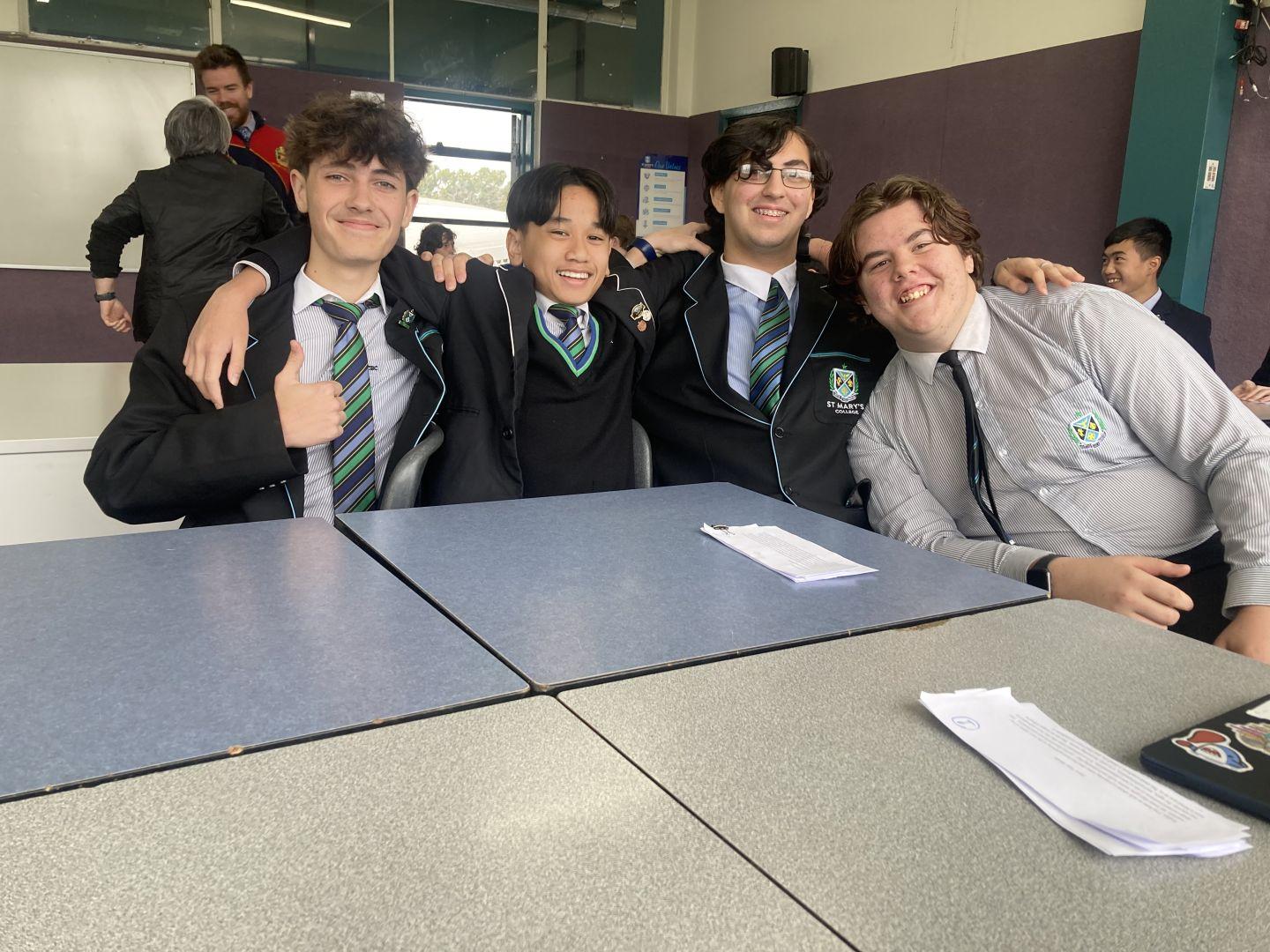
- Previous Editions
2024 Lumina Edition 6 - 10 May 2024
- Reader View
More from this issue
Served by the Norwegian Meteorological Institute and NRK
Elektrostal
Current conditions, weather forecast for the next 10 days, thursday 16 may, friday 17 may, saturday 18 may, sunday 19 may, monday 20 may, tuesday 21 may, wednesday 22 may, thursday 23 may, friday 24 may, saturday 25 may.

IMAGES
COMMENTS
Saint of the Day for November 21. The Story of the Presentation of the Blessed Virgin Mary. Mary's presentation was celebrated in Jerusalem in the sixth century. A church was built there in honor of this mystery. The Eastern Church was more interested in the feast, but it does appear in the West in the 11th century.
The feast of the presentation of Mary dates back to the 6th century in the East and the 15th century in the West. It is based on an ancient tradition that says Mary was taken to the temple in Jerusalem when she was 3-years-old and dedicated to God. What we celebrate on this day is the fact that God chose to dwell in Mary in a very special way.
The Presentation of the Blessed Virgin Mary, known in the East as The Entry of the Most Holy Theotokos into the Temple, is a liturgical feast celebrated on November 21 [1] by the Catholic, Eastern Orthodox, and some Anglo-Catholic Churches. The feast is associated with an event recounted not in the New Testament, but in the apocryphal ...
The Feast of the Presentation of the Blessed Virgin Mary, celebrated annually on November 21st, commemorates the presentation of the Blessed Virgin as a child by her parents in the Temple in ...
Liturgical Feasts 21 November. The Memorial of the Presentation of the Blessed Virgin Mary in the Temple recalls - according to the apocryphal gospels, the day on which Mary, while still a child, was brought to the temple in Jerusalem to be offered to God. The Church wants to emphasize not so much the historical event in itself, of which ...
The Feast of the Presentation. According to the Church's liturgical calendar, the feast held on Feb. 2 each year is in honor of the Presentation of the Lord. Some Catholics recall this day as the feast of the Purification of the Blessed Virgin Mary because such was the feast day named until the 1969 changes in the Church's calendar.
Jesus ascended up to Heaven, and took us with Him. Celebrate the Ascension of the Lord on May 9 or May 12, depending on your diocese. By tradition, the Virgin Mary was presented by her parents, St. Joachim and St. Anne, to the Temple in Jerusalem at a very early age. We celebrate the feast on Nov. 21.
Feast of the Annunciation. Presentation of the Virgin Mary, feast celebrated in the Roman Catholic and Eastern churches on November 21. It was held in the Eastern church in the 6th century but did not become widely accepted in the West until the 15th century. The pope St. Pius V (1566-72) suppressed it, but in 1585 Pope Sixtus V reestablished ...
Candlemas, also known as the Feast of the Presentation of Jesus Christ, the Feast of the Purification of the Blessed Virgin Mary, or the Feast of the Holy Encounter, is a Christian feast day commemorating the presentation of Jesus at the Temple by Joseph and Mary.It is based upon the account of the presentation of Jesus in Luke 2:22-40.According to the Old Testament rules in Leviticus 12, a ...
In this holy marriage we admire the incomparable chastity of Mary and Joseph; and the sanctity and honour, as well as the patronage and example, which that holy state receives from this mystery. In certain particular churches the espousals of the Virgin Mary and St. Joseph are honoured with an office on the 23rd of January.
The Feast of the Presentation of the Blessed Virgin Mary first made its way to the West through monasteries in Southern Italy in the ninth century; by the 11th century, it had spread to other locales but was by no means universally celebrated. Under the influence of a French nobleman, Philippe de Mazières, Pope Gregory XI began celebrating the ...
2016. Today we celebrate the memorial of the Presentation of the Blessed Virgin Mary. Church tradition holds that at a young age, Mary was presented to the Lord in the temple by her parents Joachim and Anna. It was there, in the temple, that Mary was dedicated to the Lord and made her vow of chastity. She lived and grew up in the temple until ...
Presentation of the Blessed Virgin Mary, FEAST of THE.—The Protoevangel of James, the Gospel of Pseudo-Matthew, the Gospel of the Nativity of Mary, and other apocryphal writings (Walker, "Apocryph. Gosp.", Edinburgh, 1873) relate that Mary, at the age of three, was brought by her parents to the Temple, in fulfilment of a vow, there to be ...
The presentation of the Blessed Virgin Mary is a feast day that commemorates Mary's presentation to the temple as a child. It is celebrated on November 21. This feast day is celebrated by many churches, and it has a long history dating back to the 6th century.
The feast of the Presentation of the Blessed Virgin Mary signifies the lifelong and total devotion that Mary made to God through her Immaculate Conception. She listened to the voice of God while still in her childhood and agreed to become the temple of Jesus Christ, the Son of God .
This feast day celebrates both the Presentation of Jesus in the Temple, as well as the Purification of Mary, which was required by the Mosaic Law forty days after the birth of a child. The Church celebrates the feast of the Presentation of the Lord on February 2, also called Candlemas for the custom of using lighted candles.
November 21st is the feast of the Presentation of the Blessed Virgin Mary. According to tradition, the Blessed Virgin Mary was consecrated to God as a young child and was given by her holy parents, St. Anne and St. Joachim, to live in the Jewish temple in Jerusalem. This special feast day honoring this event appeared in the East much earlier than it did in the West.
The feast was celebrated beginning in the ninth century, and was introduced into the official Catholic calendar in 1585. It is the final feast in the Marian Cycle, also containing the Nativity of Mary and the Holy Name of Mary, corresponding to the cycle of feasts of Jesus: Christmas, Holy Name of Jesus, and the Presentation of Jesus.
Today the Church celebrates the Memorial of the Presentation of Mary. The cycle of these three Marian feasts: the Birthday of Our Lady (September 8), the Holy Name of Mary (September 12) and her ...
Take Ascension Day as a prime example. Since the 1983 Code of Canon Law (CIC), bishops' conferences have been permitted, with the approval of the Holy See, to direct the observance of weekday holy days to Sunday. This permission is different from an older practice of observing an "external solemnity"—repeating a weekday feast on the ...
Today is the Feast of St. Matthias, Apostle and Martyr. ... the Month of Mary; No. 13: St. Matthias ... until that day when the kingdom of Jesus shall have attained the measure of its fulness.
The Nativity of Virgin Mary Cathedral is the oldest building in the monastery and among the oldest buildings in the Moscow Region. It was built between 1404 and 1405 during the lifetime of St Sabbas and using the funds of Prince Yury of Zvenigorod. The white-stone cathedral is a standard four-pillar design with a single golden dome.
Burial 5 was the most unique, it was found in a coffin made of a larch trunk, with a tightly closed lid. Due to the preservative properties of larch and lack of air access, the coffin contained a well-preserved mummy of a child with an accompanying set of grave goods. The interred individual retained the skin on his face and had a leather ...
St Mary's College acknowledged the Feast Day of Blessed Edmund Rice on Monday, 6th May and it was a day of great celebration. As my first experience of our feast day, I was impressed by the generosity of spirit on demonstration during the day. ... In recent weeks, I made a clear and concise presentation to each year level group on the issue ...
17° / 1°. 0 mm. 3 m/s. Open hourly forecast. Updated 08:28. How often is the weather forecast updated? Forecast as PDF Forecast as SVG. Weather forecast for Elektrostal for the next 10 days.
Its a city in the Moscow region. As much effort they take in making nice flags, as low is the effort in naming places. The city was founded because they built factories there.